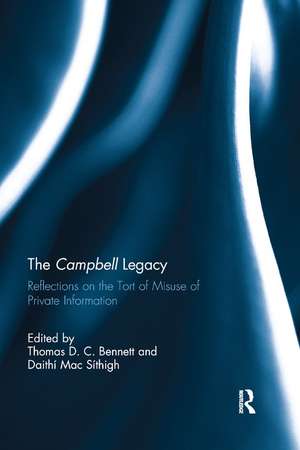The Campbell Legacy: Reflections on the Tort of Misuse of Private Information
Editat de Thomas D.C. Bennett, Daithí Mac Síthighen Limba Engleză Paperback – 12 dec 2019
Preț: 257.68 lei
Preț vechi: 310.22 lei
-17% Nou
Puncte Express: 387
Preț estimativ în valută:
49.31€ • 51.42$ • 40.98£
49.31€ • 51.42$ • 40.98£
Carte tipărită la comandă
Livrare economică 20 martie-03 aprilie
Preluare comenzi: 021 569.72.76
Specificații
ISBN-13: 9780367890377
ISBN-10: 0367890372
Pagini: 182
Dimensiuni: 156 x 234 mm
Greutate: 0.34 kg
Ediția:1
Editura: Taylor & Francis
Colecția Routledge
Locul publicării:Oxford, United Kingdom
ISBN-10: 0367890372
Pagini: 182
Dimensiuni: 156 x 234 mm
Greutate: 0.34 kg
Ediția:1
Editura: Taylor & Francis
Colecția Routledge
Locul publicării:Oxford, United Kingdom
Public țintă
Postgraduate, Professional, and UndergraduateCuprins
Introduction: The Campbell Legacy 1. Liability for listening: why phone hacking is an actionable breach of privacy 2. A landmark at a turning point: Campbell and the use of privacy law to constrain media power 3. A just balance or just imbalance? The role of metaphor in misuse of private information 4. Protecting private information of public interest: Campbell’s great promise, unfulfilled 5. Privacy, third parties and judicial method: Wainwright’s legacy of uncertainty 6. The harms of privacy
Notă biografică
Thomas D.C. Bennett is a Lecturer in Law at Newcastle University, UK. He has written on the development of privacy torts in the UK and across the common law world.
Daithí Mac Síthigh is Professor of Law and Innovation at Queen's University Belfast, UK. His research interests are in law and technology.
Daithí Mac Síthigh is Professor of Law and Innovation at Queen's University Belfast, UK. His research interests are in law and technology.
Descriere
Naomi Campbell’s case against Mirror Group Newspapers in 2004 gave rise to a decade of rapid changes in privacy laws. In this book, experts address the legacy of this case, identifying broad themes such as power, consistency, and technological change. This book was originally published as a special issue of the Journal of Media Law.
